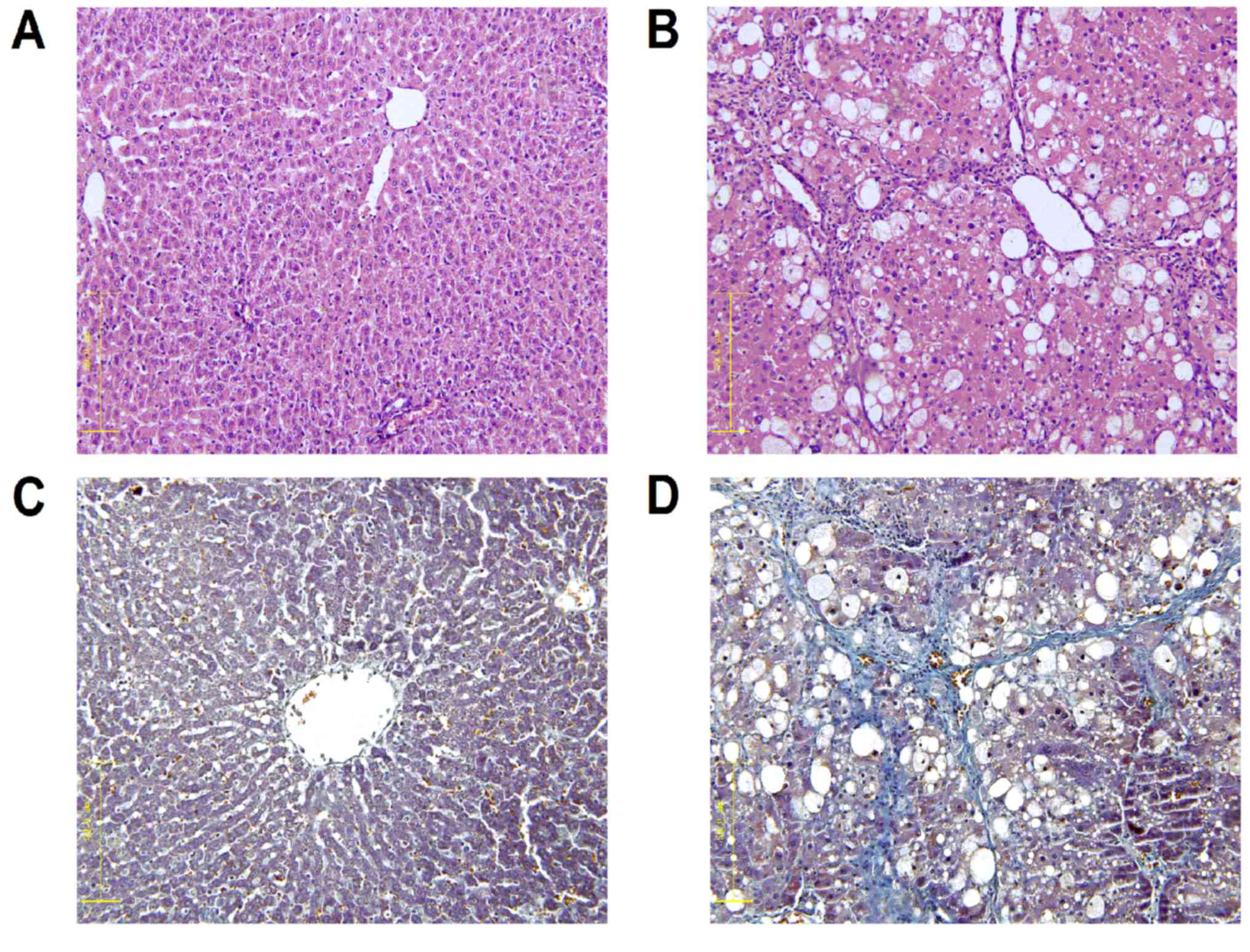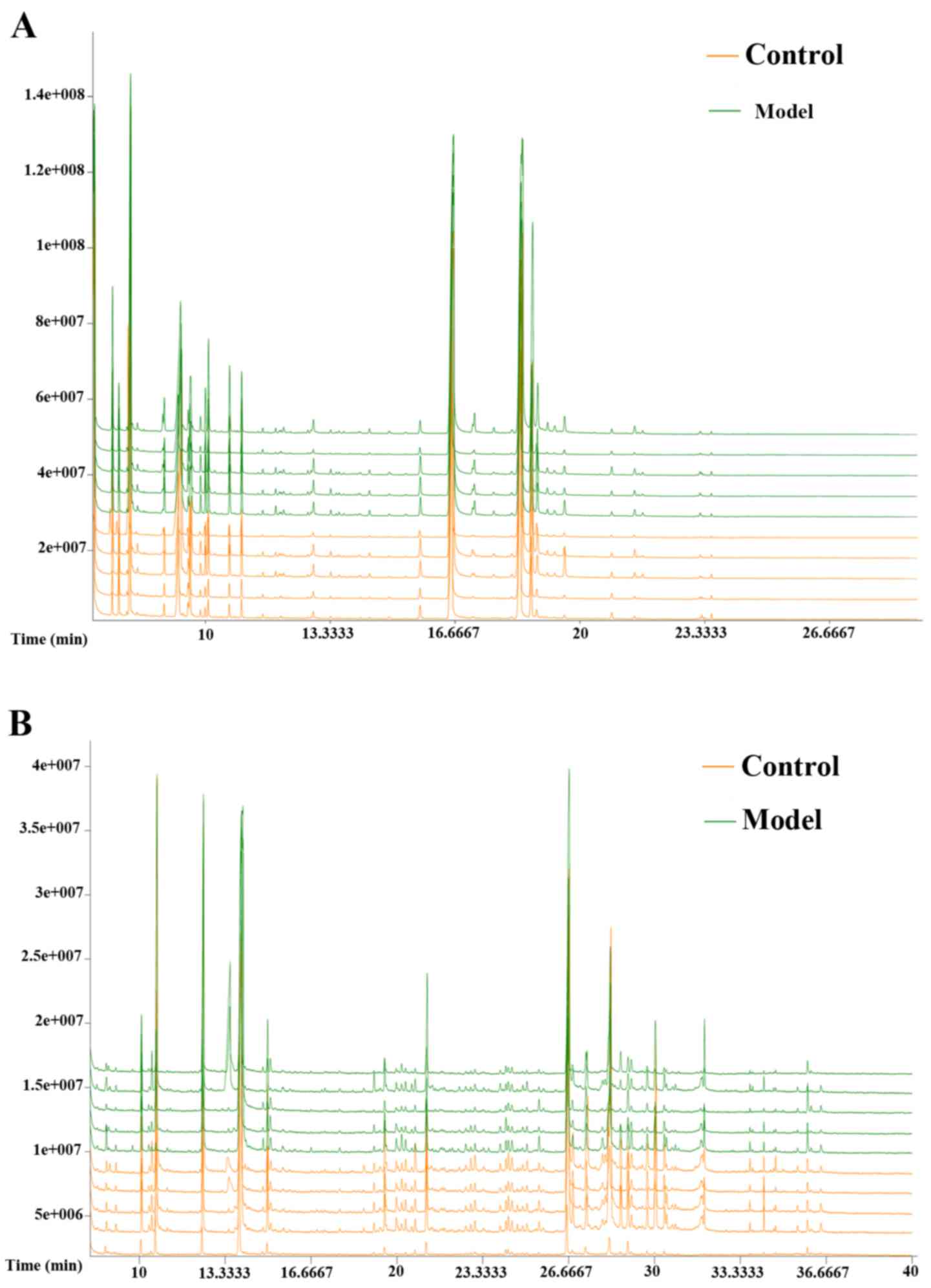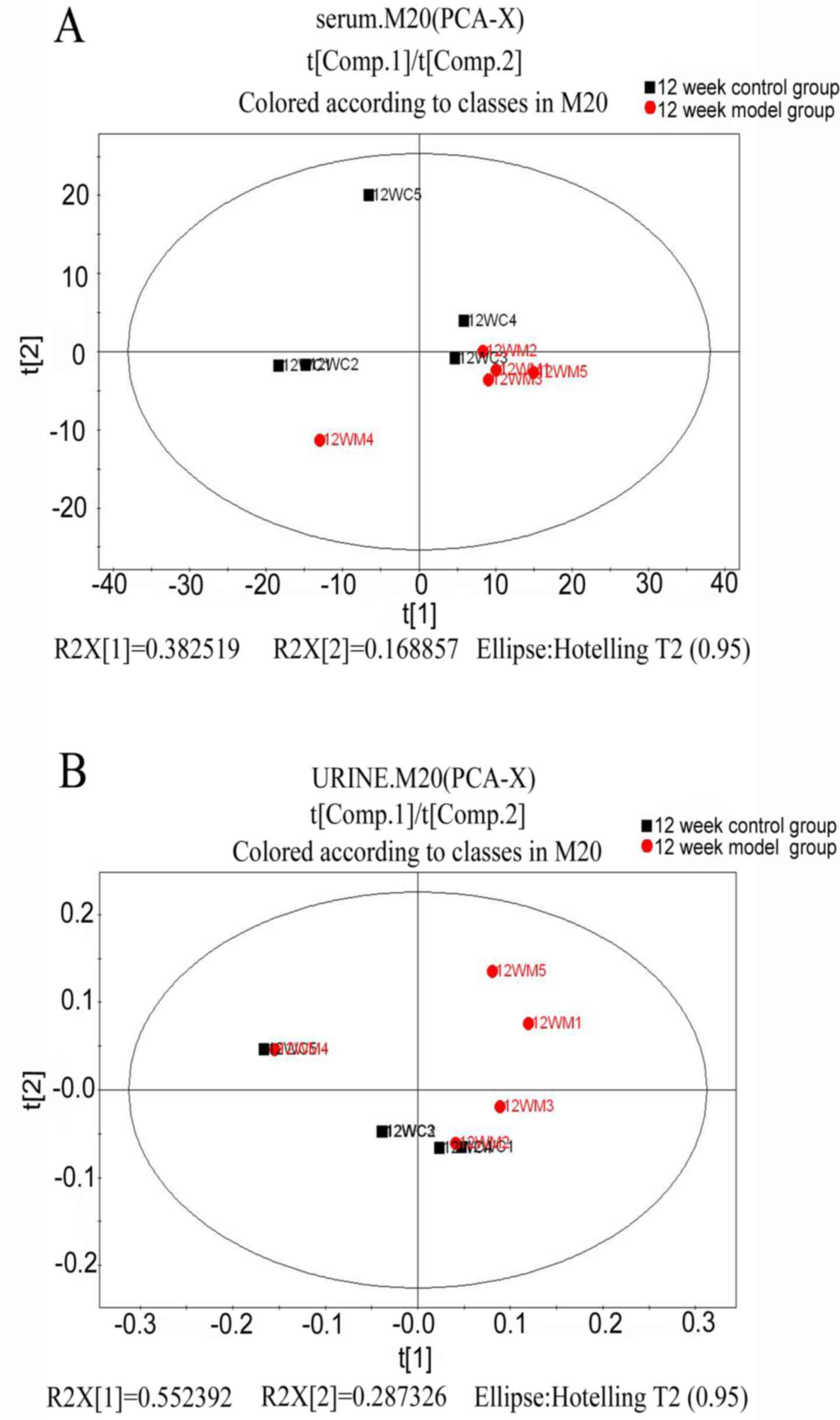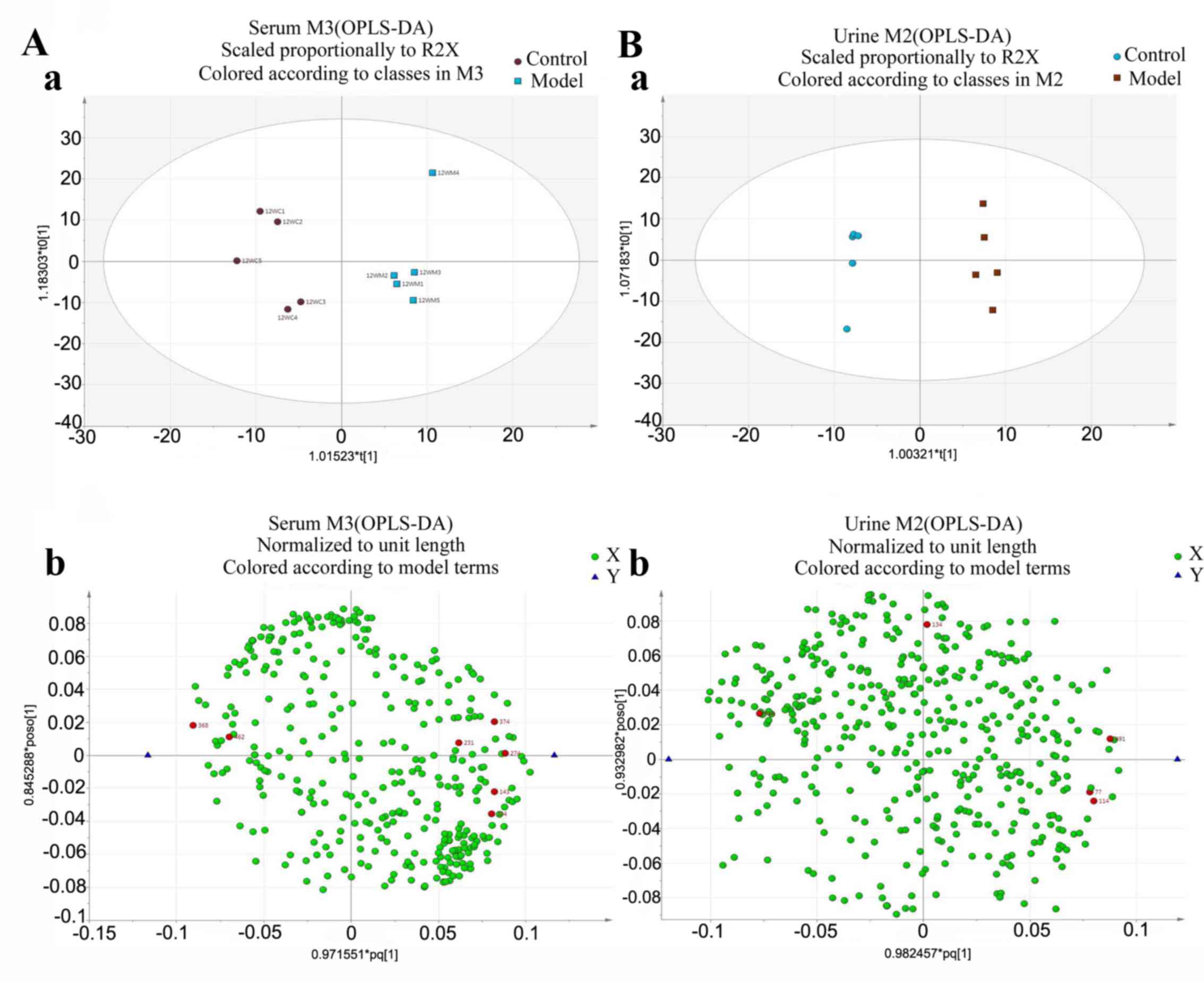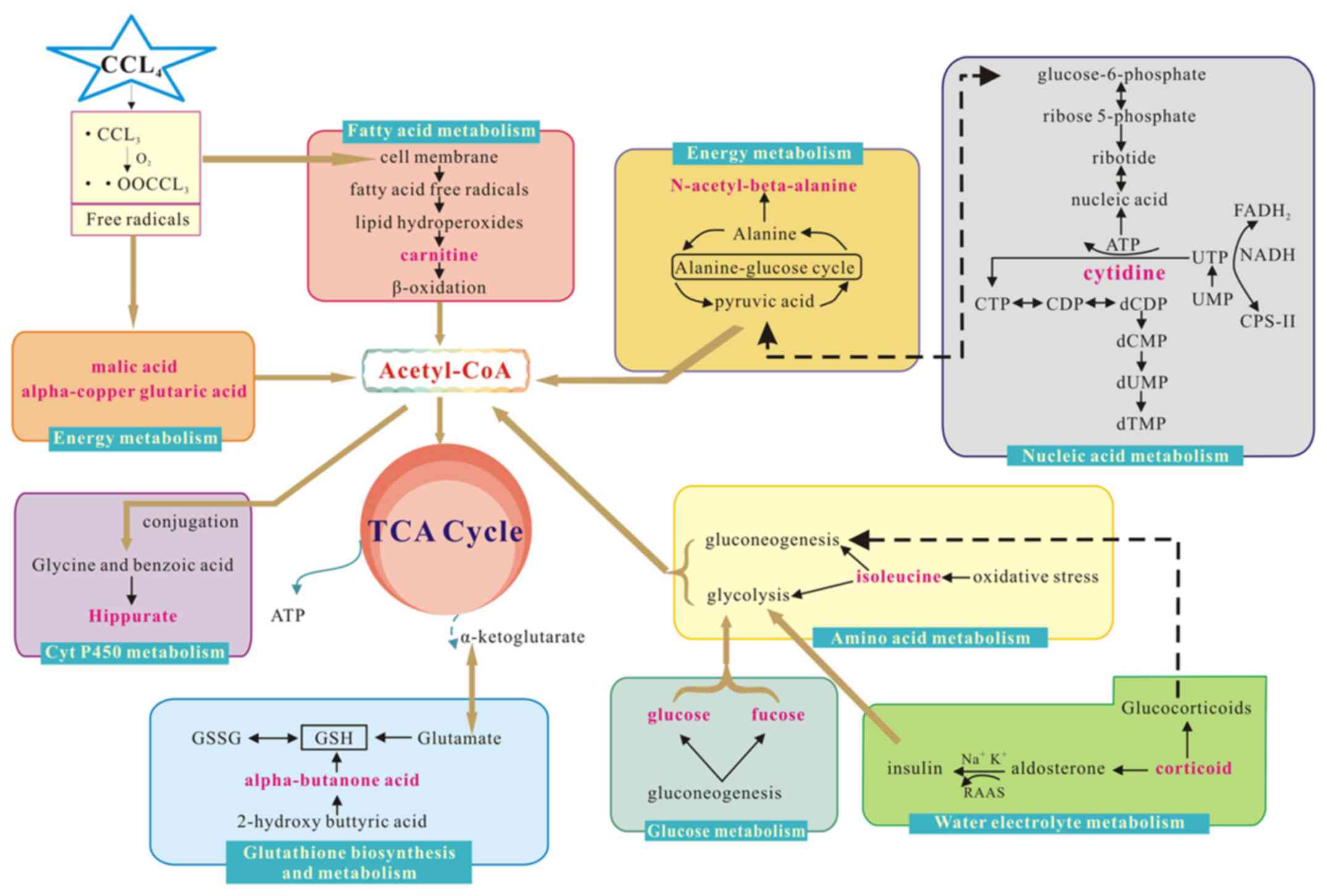|
1
|
Zira A, Kostidis S, Theocharis S, Sigala
F, Engelsen SB, Andreadou I and Mikros E: 1H NMR-based metabonomics
approach in a rat model of acute liver injury and regeneration
induced by CCl4 administration. Toxicology. 303:115–124. 2013.
View Article : Google Scholar : PubMed/NCBI
|
|
2
|
Zheng J, Wu C, Lin Z, Guo Y, Shi L, Dong
P, Lu Z, Gao S, Liao Y, Chen B and Yu F: Curcumin up-regulates
phosphatase and tensin homologue deleted on chromosome 10 through
microRNA-mediated control of DNA methylation-a novel mechanism
suppressing liver fibrosis. FEBS J. 281:88–103. 2014. View Article : Google Scholar : PubMed/NCBI
|
|
3
|
Zhang S, Wu J, Wang H, Wang T, Jin L, Shu
D, Shan W and Xiong S: Liposomal oxymatrine in hepatic fibrosis
treatment: Formulation, in vitro and in vivo assessment. AAPS
PharmSciTech. 15:620–629. 2014. View Article : Google Scholar : PubMed/NCBI
|
|
4
|
Sun LL, Chang W, Jiao LQ, Cui X and Dong
G: Hepatic fibrosis and supersonic shear imaging in patients with
different etiological chronic hepatic diseases. J Biol Regul
Homeost Agents. 30:761–765. 2016.PubMed/NCBI
|
|
5
|
Seo KW, Sohn SY, Bhang DH, Nam MJ, Lee HW
and Youn HY: Therapeutic effects of hepatocyte growth
factor-overexpressing human umbilical cord blood-derived
mesenchymal stem cells on liver fibrosis in rats. Cell Biol Int.
38:106–116. 2014. View Article : Google Scholar : PubMed/NCBI
|
|
6
|
Lee JE, Lee JM, Lee KB, Yoon JH, Shin CI,
Han JK and Choi BI: Noninvasive assessment of hepatic fibrosis in
patients with chronic hepatitis B viral infection using magnetic
resonance elastography. Korean J Radiol. 15:210–217. 2014.
View Article : Google Scholar : PubMed/NCBI
|
|
7
|
Ozkurt H, Keskiner F, Karatag O, Alkim C,
Erturk SM and Basak M: Diffusion weighted MRI for hepatic fibrosis:
Impact of b-Value. Iran J Radiol. 11:e35552014.PubMed/NCBI
|
|
8
|
Lu Q, Luo Y, Yuan CX, Yan LN, Wu H and
Zhang ZW: Ultrasound imaging of bridge vessel transplant used to
reconstruct the tributary of middle hepatic vein in living donor
liver transplantation. Sichuan Da Xue Xue Bao Yi Xue Ban.
38:529–531. 2007.(In Chinese). PubMed/NCBI
|
|
9
|
Duan J, Hu C, Luo S, Zhao X and Wang T:
Microcomputed tomography with diffraction-enhanced imaging for
morphologic characterization and quantitative evaluation of
microvessel of hepatic fibrosis in rats. PLoS One. 8:e781762013.
View Article : Google Scholar : PubMed/NCBI
|
|
10
|
Razek AA, Khashaba M, Abdalla A, Bayomy M
and Barakat T: Apparent diffusion coefficient value of hepatic
fibrosis and inflammation in children with chronic hepatitis.
Radiol Med. 119:903–909. 2014. View Article : Google Scholar : PubMed/NCBI
|
|
11
|
Leeming DJ, Byrjalsen I, Jiménez W,
Christiansen C and Karsdal MA: Protein fingerprinting of the
extracellular matrix remodelling in a rat model of liver fibrosis-a
serological evaluation. Liver Int. 33:439–447. 2013. View Article : Google Scholar : PubMed/NCBI
|
|
12
|
Manna SK, Thompson MD and Gonzalez FJ:
Application of mass spectrometry-based metabolomics in
identification of early noninvasive biomarkers of alcohol-induced
liver disease using mouse model. Adv Exp Med Biol. 815:217–238.
2015. View Article : Google Scholar : PubMed/NCBI
|
|
13
|
Huang X, Shao L, Gong Y, Mao Y, Liu C, Qu
H and Cheng Y: A metabonomic characterization of CCl4-induced acute
liver failure using partial least square regression based on the
GC/MS metabolic profiles of plasma in mice. J Chromatogr B Analyt
Technol Biomed Life Sci. 870:178–185. 2008. View Article : Google Scholar : PubMed/NCBI
|
|
14
|
Gou X, Tao Q, Feng Q, Peng J, Zhao Y, Dai
J, Wang W, Zhang Y, Hu Y and Liu P: Urine metabolic profile changes
of CCl4-liver fibrosis in rats and intervention effects of Yi Guan
Jian Decoction using metabonomic approach. BMC Complement Altern
Med. 13:1232013. View Article : Google Scholar : PubMed/NCBI
|
|
15
|
Ressom HW, Xiao JF, Tuli L, Varghese RS,
Zhou B, Tsai TH, Ranjbar MR, Zhao Y, Wang J, Di Poto C, et al:
Utilization of metabolomics to identify serum biomarkers for
hepatocellular carcinoma in patients with liver cirrhosis. Anal
Chim Acta. 743:90–100. 2012. View Article : Google Scholar : PubMed/NCBI
|
|
16
|
Wu H, Liu T, Ma C, Xue R, Deng C, Zeng H
and Shen X: GC/MS-based metabolomic approach to validate the role
of urinary sarcosine and target biomarkers for human prostate
cancer by microwave-assisted derivatization. Anal Bioanal Chem.
401:635–646. 2011. View Article : Google Scholar : PubMed/NCBI
|
|
17
|
Sun S, Dai J, Fang J, Gou X, Cao H, Zheng
N, Wang Y, Zhang W, Zhang Y, Jia W and Hu Y: Differences of excess
and deficiency zheng in patients with chronic hepatitis B by
urinary metabonomics. Evid Based Complement Alternat Med.
2013:7382452013. View Article : Google Scholar : PubMed/NCBI
|
|
18
|
Feng B, Wu S, Liu F, Gao Y, Dong F and Wei
L: Metabonomic analysis of liver tissue from BALB/c mice with
D-galactosamine/lipopolysaccharide-induced acute hepatic failure.
BMC Gastroenterol. 13:732013. View Article : Google Scholar : PubMed/NCBI
|
|
19
|
Yu K, Sheng G, Sheng J, Chen Y, Xu W, Liu
X, Cao H, Qu H, Cheng Y and Li L: A metabonomic investigation on
the biochemical perturbation in liver failure patients caused by
hepatitis B virus. J Proteome Res. 6:2413–2419. 2007. View Article : Google Scholar : PubMed/NCBI
|
|
20
|
Lin B, Zhang H, Lin Z, Fang Y, Tian L,
Yang H, Yan J, Liu H, Zhang W and Xi Z: Studies of single-walled
carbon nanotubes-induced hepatotoxicity by NMR-based metabonomics
of rat blood plasma and liver extracts. Nanoscale Res Lett.
8:2362013. View Article : Google Scholar : PubMed/NCBI
|
|
21
|
Chen J, Wang W, Lv S, Yin P, Zhao X, Lu X,
Zhang F and Xu G: Metabonomics study of liver cancer based on ultra
performance liquid chromatography coupled to mass spectrometry with
HILIC and RPLC separations. Anal Chim Acta. 650:3–9. 2009.
View Article : Google Scholar : PubMed/NCBI
|
|
22
|
Ma J, Yu J, Su X, Zhu C, Yang X, Sun H,
Chen D, Wang Y, Cao H and Lu J: UPLC-MS-based serum metabonomics
for identifying acute liver injury biomarkers in Chinese miniature
pigs. Toxicol Lett. 225:358–366. 2014. View Article : Google Scholar : PubMed/NCBI
|
|
23
|
Chen B, Ye B, Zhang J, Ying L and Chen Y:
RDW to platelet ratio: A novel noninvasive index for predicting
hepatic fibrosis and cirrhosis in chronic hepatitis B. PLoS One.
8:e687802013. View Article : Google Scholar : PubMed/NCBI
|
|
24
|
Frias M, Rodriguez-Cano D, Cuenca-López F,
Macías J, Gordon A, Manzanares-Martín B, Pineda JA, Camacho Á,
Torre-Cisneros J, Peña J, et al: HLA-B18 as risk factor of liver
fibrosis progression in HIV/HCV treatment-experienced patients.
Pharmacogenomics J. Oct 25–2016.(Epub ahead of print). View Article : Google Scholar
|
|
25
|
Chheda TK, Shivakumar P, Sadasivan SK,
Chanderasekharan H, Moolemath Y, Oommen AM, Madanahalli JR and
Marikunte VV: Fast food diet with CCl4 micro-dose induced
hepatic-fibrosis-a novel animal model. BMC Gastroenterol.
14:892014. View Article : Google Scholar : PubMed/NCBI
|
|
26
|
Gou X, Tao Q, Feng Q, Peng J, Sun S, Cao
H, Zheng N, Zhang Y, Hu Y and Liu P: Urinary metabonomics
characterization of liver fibrosis induced by CCl4 in rats and
intervention effects of Xia Yu Xue Decoction. J Pharm Biomed Anal.
74:62–65. 2013. View Article : Google Scholar : PubMed/NCBI
|
|
27
|
Sun H, Zhang AH, Zou DX, Sun WJ, Wu XH and
Wang XJ: Metabolomics coupled with pattern recognition and pathway
analysis on potential biomarkers in liver injury and
hepatoprotective effects of yinchenhao. Appl Biochem Biotechnol.
173:857–869. 2014. View Article : Google Scholar : PubMed/NCBI
|
|
28
|
Giudetti AM, Stanca E, Siculella L, Gnoni
GV and Damiano F: Nutritional and hormonal regulation of citrate
and carnitine/acylcarnitine transporters: Two mitochondrial
carriers involved in fatty acid metabolism. Int J Mol Sci. 17(pii):
E8172016. View Article : Google Scholar : PubMed/NCBI
|
|
29
|
Demiroren K, Dogan Y, Kocamaz H, Ozercan
IH, Ilhan S, Ustundag B and Bahcecioglu IH: Protective effects of
L-carnitine, N-acetylcysteine and genistein in an experimental
model of liver fibrosis. Clin Res Hepatol Gastroenterol. 38:63–72.
2014. View Article : Google Scholar : PubMed/NCBI
|
|
30
|
Muroya Y, Ito O, Rong R, Takashima K, Ito
D, Cao P, Nakamura Y, Joh K and Kohzuki M: Disorder of fatty acid
metabolism in the kidney of PAN-induced nephrotic rats. Am J
Physiol Renal Physiol. 303:F1070–F1079. 2012. View Article : Google Scholar : PubMed/NCBI
|
|
31
|
Manco M and Nobili V: Beta-cell glucose
sensitivity in patients with liver fibrosis. Gut.
57:10232008.PubMed/NCBI
|
|
32
|
Haukeland JW, Konopski Z, Linnestad P,
Azimy S, Løberg E Marit, Haaland T, Birkeland K and Bjøro K:
Abnormal glucose tolerance is a predictor of steatohepatitis and
fibrosis in patients with non-alcoholic fatty liver disease. Scand
J Gastroenterol. 40:1469–1477. 2005. View Article : Google Scholar : PubMed/NCBI
|
|
33
|
Zant R, Melter M, Beck D, Ameres M,
Knoppke B and Kunkel J: Glucose metabolism and associated outcome
after pediatric liver transplantation. Transplant Proc.
48:2709–2713. 2016. View Article : Google Scholar : PubMed/NCBI
|
|
34
|
Haraguchi M, Miyaaki H, Ichikawa T,
Shibata H, Honda T, Ozawa E, Miuma S, Taura N, Takeshima F and
Nakao K: Glucose fluctuations reduce quality of sleep and of life
in patients with liver cirrhosis. Hepatol Int. 11:125–131. 2017.
View Article : Google Scholar : PubMed/NCBI
|
|
35
|
Bala S, Csak T, Saha B, Zatsiorsky J,
Kodys K, Catalano D, Satishchandran A and Szabo G: The
pro-inflammatory effects of miR-155 promote liver fibrosis and
alcohol-induced steatohepatitis. J Hepatol. 64:1378–1387. 2016.
View Article : Google Scholar : PubMed/NCBI
|
|
36
|
Araújo Júnior RF, Garcia VB, Leitão RF,
Brito GA, Ede C Miguel, Guedes PM and de Araújo A: Carvedilol
improves inflammatory response, oxidative stress and fibrosis in
the alcohol-induced liver injury in rats by regulating kuppfer
cells and hepatic stellate cells. PLoS One. 11:e01488682016.
View Article : Google Scholar : PubMed/NCBI
|
|
37
|
Wang H, Zhang Y, Wang T, You H and Jia J:
N-methyl-4-isoleucine cyclosporine attenuates CCl -induced liver
fibrosis in rats by interacting with cyclophilin B and D. J
Gastroenterol Hepatol. 26:558–567. 2011. View Article : Google Scholar : PubMed/NCBI
|
|
38
|
Tajiri K and Shimizu Y: Branched-chain
amino acids in liver diseases. World J Gastroenterol. 19:7620–7629.
2013. View Article : Google Scholar : PubMed/NCBI
|
|
39
|
Britton RS and Bacon BR: Role of free
radicals in liver diseases and hepatic fibrosis.
Hepatogastroenterology. 41:343–348. 1994.PubMed/NCBI
|
|
40
|
Miyake M, Innami T and Kakimoto Y: A
beta-citryl-L-glutamate-hydrolysing enzyme in rat testes. Biochim
Biophys Acta. 760:206–214. 1983. View Article : Google Scholar : PubMed/NCBI
|
|
41
|
Kadotani A, Fujimura M, Nakamura T, Ohyama
S, Harada N, Maruki H, Tamai Y, Kanatani A and Eiki J: Metabolic
impact of overexpression of liver glycogen synthase with
serine-to-alanine substitutions in rat primary hepatocytes. Arch
Biochem Biophys. 466:283–289. 2007. View Article : Google Scholar : PubMed/NCBI
|
|
42
|
Burelle Y, Fillipi C, Péronnet F and
Leverve X: Mechanisms of increased gluconeogenesis from alanine in
rat isolated hepatocytes after endurance training. Am J Physiol
Endocrinol Metab. 278:E35–E42. 2000.PubMed/NCBI
|
|
43
|
Volpe DA, Tobin GA, Tavakkoli F, Dowling
TC, Light PD and Parker RJ: Effect of uremic serum and uremic
toxins on drug metabolism in human microsomes. Regul Toxicol
Pharmacol. 68:297–303. 2014. View Article : Google Scholar : PubMed/NCBI
|
|
44
|
Bouthillier LP, Pushpathadam JJ and
Binette Y: Study of the metabolism of 2-hydroxy-4-amino-butyric
acid, a product of gamma-hydroxyglutamic acid decarboxylation. Can
J Biochem. 44:171–177. 1966. View Article : Google Scholar : PubMed/NCBI
|
|
45
|
Gallagher EP, Gardner JL and Barber DS:
Several glutathione S-transferase isozymes that protect against
oxidative injury are expressed in human liver mitochondria. Biochem
Pharmacol. 71:1619–1628. 2006. View Article : Google Scholar : PubMed/NCBI
|
|
46
|
Cai J, Gong R, Yan F, Yu C, Liu L, Wang W,
Lin Y, Guo M, Li W and Huang Z: ZNF300 knockdown inhibits forced
megakaryocytic differentiation by phorbol and erythrocytic
differentiation by arabinofuranosyl cytidine in K562 cells. PLoS
One. 9:e1147682014. View Article : Google Scholar : PubMed/NCBI
|
|
47
|
Masoumi A, Ortiz F, Radhakrishnan J,
Schrier RW and Colombo PC: Mineralocorticoid receptor antagonists
as diuretics: Can congestive heart failure learn from liver
failure? Heart Fail Rev. 20:283–290. 2015. View Article : Google Scholar : PubMed/NCBI
|
|
48
|
Queisser N, Happ K, Link S, Jahn D, Zimnol
A, Geier A and Schupp N: Aldosterone induces fibrosis, oxidative
stress and DNA damage in livers of male rats independent of blood
pressure changes. Toxicol Appl Pharmacol. 280:399–407. 2014.
View Article : Google Scholar : PubMed/NCBI
|



